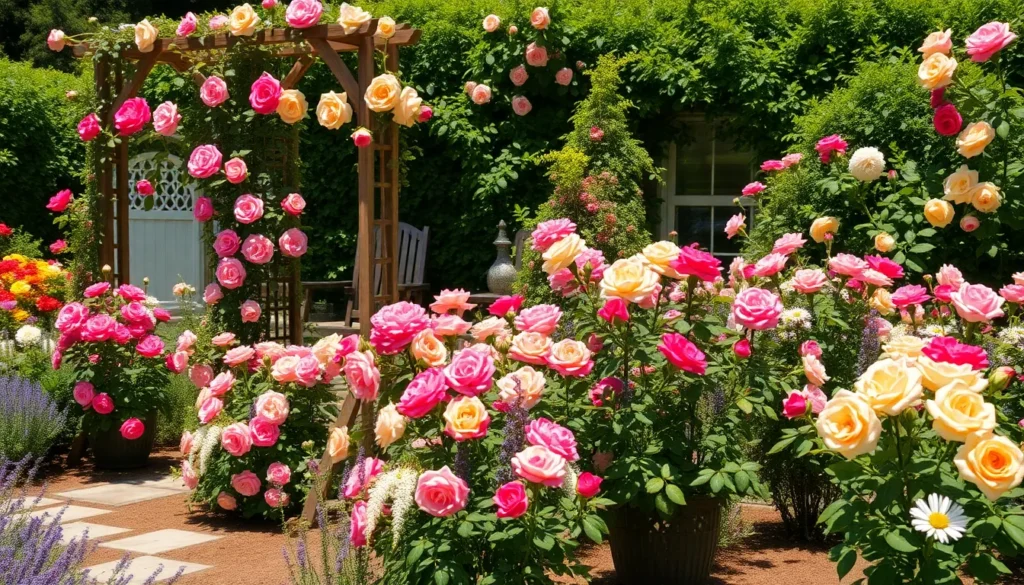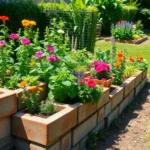Creating a stunning rose garden transforms any outdoor space into a fragrant paradise that captivates both the eye and soul. Whether you’re working with a sprawling backyard or a cozy corner plot, we’ve discovered that thoughtful planning and creative design choices make all the difference in cultivating roses that bloom magnificently year after year.
We’ll explore innovative ideas that go beyond traditional rose bed layouts, from vertical climbing displays to companion planting strategies that enhance both beauty and plant health. Our proven techniques help gardeners at every level design spaces where roses truly thrive.
From selecting the perfect varieties for your climate to incorporating hardscape elements that complement your blooms, we’re sharing practical answers that turn rose gardening dreams into reality. Let’s jump into these inspiring ideas that’ll help you create the rose garden you’ve always envisioned.
Choose the Perfect Location for Your Rose Garden
Selecting the right spot sets the foundation for a thriving rose garden that’ll bloom magnificently throughout the growing season. We need to evaluate three critical environmental factors to ensure our roses receive optimal growing conditions.
Consider Sunlight Requirements
Morning sun exposure provides the most crucial lighting for healthy rose development. Most rose varieties need 6 to 8 hours of direct sunlight daily to produce abundant blooms and maintain strong disease resistance. We recommend choosing locations that receive morning sunlight since it helps dry dew from leaves quickly and reduces fungal problems.
Eastern and southern exposures typically offer the best sun patterns for rose gardens. These orientations capture morning light while providing afternoon sun without excessive late-day heat stress. Avoid planting roses in areas that only receive afternoon sun, as this intense heat can damage blooms and stress plants during summer months.
Partial shade locations work for exact rose types but limit variety selection. Climbing roses and some shrub varieties tolerate 4 to 6 hours of sunlight, though they’ll produce fewer flowers. We suggest avoiding heavily shaded areas under large trees or north-facing walls where roses struggle to establish strong root systems.
Evaluate Soil Drainage Conditions
Well-draining soil prevents root rot and creates optimal growing conditions for roses. Standing water around rose roots causes serious problems including black spot, crown gall, and eventual plant death. We can test drainage by digging a hole 12 inches deep and filling it with water to see how quickly it drains.
Sandy loam soil provides the ideal balance of drainage and moisture retention. This soil type allows excess water to flow away while maintaining enough moisture for healthy root development. Heavy clay soils require amendments like compost, perlite, or coarse sand to improve drainage before planting roses.
Raised beds offer excellent drainage answers for problematic soil conditions. Building beds 6 to 12 inches above ground level ensures proper water flow while allowing us to control soil composition. We can fill raised beds with quality garden soil mixed with organic matter to create perfect growing conditions.
Plan for Air Circulation
Adequate spacing between roses promotes healthy air movement and reduces disease pressure. Most rose varieties need 3 to 4 feet of space between plants to allow proper airflow around foliage. Crowded plantings create humid microclimates that encourage fungal diseases like powdery mildew and black spot.
Open garden areas away from dense vegetation provide optimal air circulation. Avoid planting roses in enclosed corners or against solid fences where air becomes stagnant. We prefer locations with gentle breezes that help keep leaves dry while not creating harsh wind conditions that damage delicate blooms.
Strategic placement near pathways and open lawn areas maximizes airflow benefits. These locations naturally receive better air movement while remaining accessible for maintenance tasks. Consider prevailing wind patterns in your area and position roses where they’ll benefit from natural air currents without exposure to damaging storms.
Select the Right Rose Varieties for Your Climate
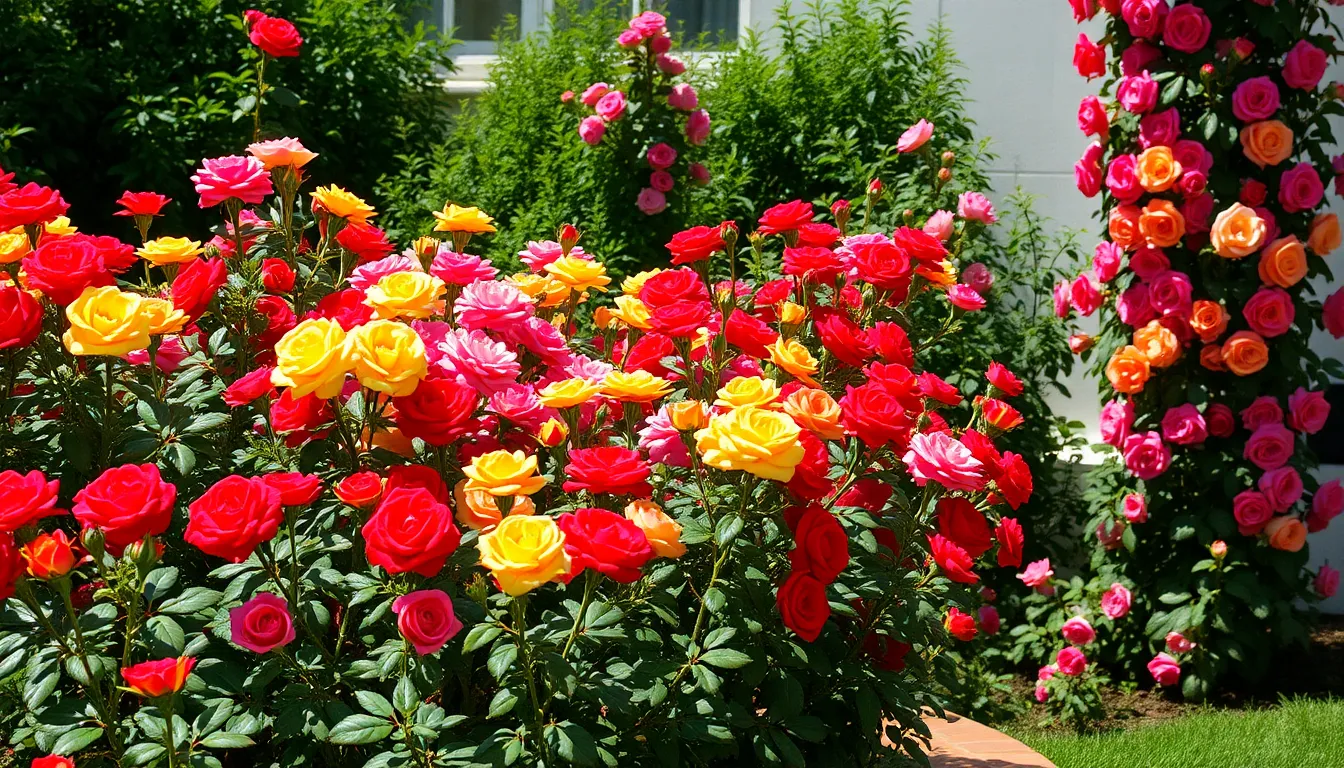
Choosing climate appropriate roses ensures our garden thrives with minimal maintenance while delivering maximum beauty. Success depends on matching rose characteristics to our exact regional growing conditions.
Research Hardy Rose Types
Disease resistant varieties form the foundation of any successful rose garden, reducing our need for chemical treatments and constant care. Modern types like Oso Easy Roses are specifically bred for vigor and extended bloom periods, making them ideal choices for busy gardeners. Traditional hybrid teas offer classic beauty, while newer varieties provide improved hardiness and disease tolerance that older cultivars often lack.
Cold hardiness ratings help us select roses that survive our winter temperatures without protection or special care. Heat tolerant varieties become essential in warmer climates where summer stress can damage sensitive rose types. We should prioritize roses bred for our exact region’s challenges, whether that’s humidity, drought, or temperature extremes.
Consider Bloom Times and Colors
Bloom scheduling creates continuous color throughout our growing season when we select early, mid season, and late flowering varieties. Early bloomers like rugosa roses start our display in late spring, while repeat flowering varieties like hybrid teas provide color through fall. Late season bloomers extend our garden’s appeal well into autumn months.
Color coordination unifies our industry design and complements our home’s exterior palette for a cohesive appearance. Warm colors like reds, oranges, and yellows create vibrant focal points, while cool tones like purples, blues, and whites provide calming balance. We can create dramatic contrast with opposing colors or gentle harmony with adjacent color wheel selections.
Match Roses to Your Garden Size
Compact varieties maximize our planting options in smaller spaces without sacrificing bloom quality or garden impact. Groundcover roses like Harlow Carr spread horizontally rather than vertically, making them perfect for borders and containers. Princess Alexandra of Kent and similar potted varieties adapt well to patios, balconies, and urban gardens with limited ground space.
Climbing roses transform vertical surfaces into living walls of color when trained on arbors, pergolas, or existing fences. Large shrub roses create natural privacy screens and hedges that serve dual purposes in expansive gardens. We can use these larger varieties to define garden rooms, create boundaries, or establish stunning backdrop plantings for smaller rose displays.
Design Your Rose Garden Layout
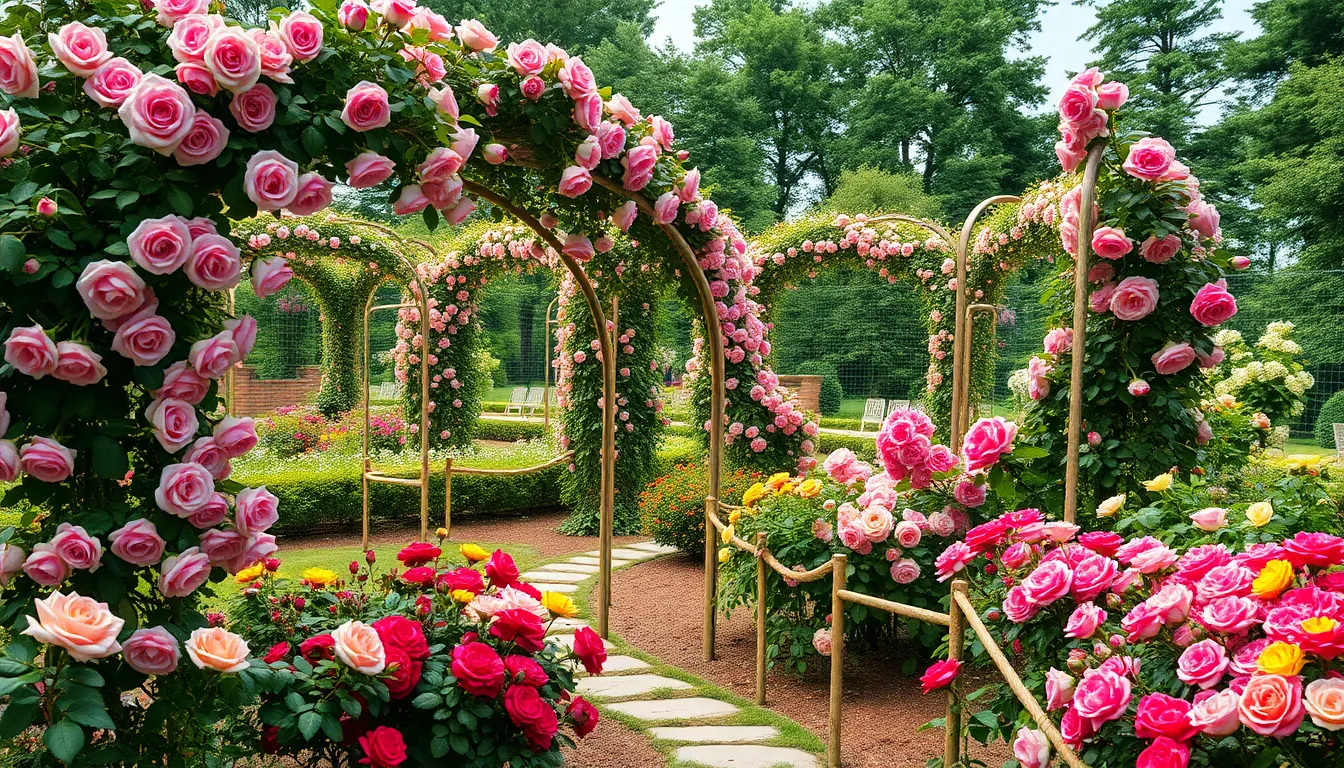
We’ll transform your outdoor space into a stunning rose paradise by thoughtfully organizing your garden layout. Strategic planning creates visual impact while ensuring your roses have room to flourish and shine.
Create Focal Points with Climbing Roses
Garden arches and arbors serve as stunning structural foundations for climbing roses that create breathtaking focal points throughout your industry. We recommend installing these features at garden entrances or pathway transitions where climbing roses can cascade overhead and frame the view beautifully.
Plant two climbing rose varieties on either side of each arch to maximize visual impact and ensure full coverage across the structure. Space them adequately so visitors can pass comfortably underneath while experiencing the fragrant blooms above their heads.
Rambling roses reach impressive heights of 50 to 60 feet and produce spectacular once yearly cluster blooms that create dramatic seasonal displays. Climbing roses offer repeated flowering with larger individual blooms that require tying to structures for proper support and training.
Plan Pathways and Walking Areas
Pathways should wind through your rose garden strategically to showcase different varieties from multiple viewing angles and create an immersive garden experience. We design curved paths that invite exploration while maintaining clear sight lines to featured rose collections.
Hardscape elements like garden benches and seating areas encourage visitors to pause and appreciate the roses’ beauty and fragrance at various points along the journey. Position these rest spots near particularly fragrant varieties or stunning color combinations for maximum enjoyment.
Maintain generous walking spaces around all plantings to prevent roses from crowding pathways or obstructing doorways as they mature and spread naturally. Leave adequate clearance for both foot traffic and garden maintenance activities throughout the growing season.
Group Roses by Color Schemes
Plant roses in drifts of 3 to 5 specimens of the same color variety to create unified displays that make powerful visual statements across your garden industry. Single plantings often get lost while larger groupings command attention and create lasting impressions.
Coordinate complementary colors within designated garden rooms to maintain cohesion while adding variety and visual interest throughout different sections of your rose garden. Separate warm tones like reds and oranges from cool purples and whites for balanced color distribution.
Larger rose gardens benefit from formal room divisions that prevent the overall design from appearing scattered or overwhelming in expansive landscapes. Use hardscape features like pergolas or planted borders to define these colorful sections while maintaining the garden’s unified aesthetic appeal.
Prepare Your Soil for Optimal Rose Growth
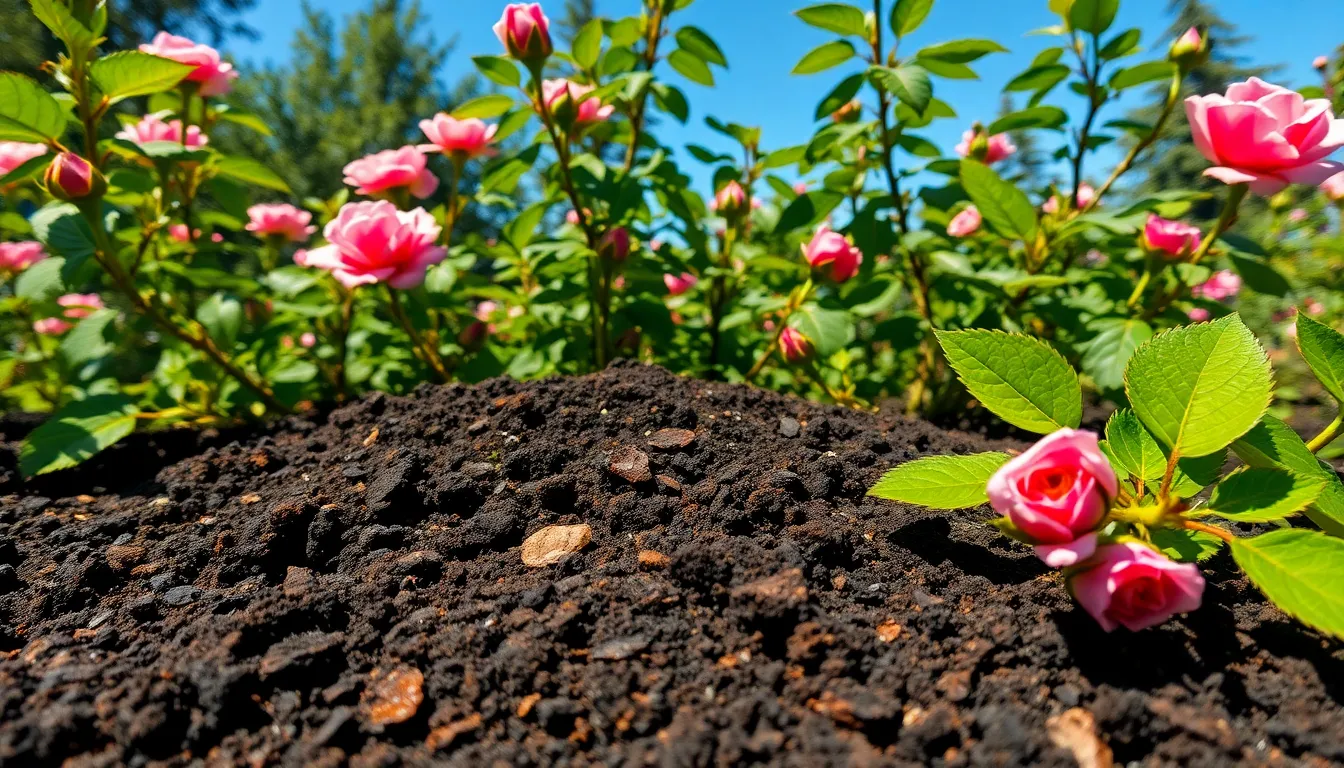
Successful rose cultivation begins with proper soil preparation that creates the foundation for healthy plant development. We’ll walk you through the essential steps to transform your garden soil into an optimal growing environment.
Test and Amend Soil pH Levels
Testing your soil’s pH levels ensures roses receive the nutrients they need for vigorous growth. Roses thrive in slightly acidic to neutral soil with a pH range between 6.0 and 7.0, which allows them to absorb essential nutrients effectively.
Purchase a digital pH meter or soil testing kit from your local garden center to get accurate readings. Take soil samples from multiple locations throughout your planned rose garden area, mixing them together for a representative sample. Send samples to your county extension office for comprehensive analysis that includes nutrient levels and organic matter content.
Amend acidic soil (below 6.0) by incorporating agricultural lime at a rate of 2 to 4 pounds per 100 square feet. Lower alkaline soil (above 7.0) using elemental sulfur or aluminum sulfate, applying 1 to 2 pounds per 100 square feet. Retest your soil after 4 to 6 weeks to monitor pH changes and make additional adjustments as needed.
Add Organic Matter and Compost
Adding organic matter transforms soil structure and provides essential nutrients that roses need for optimal growth. Compost improves soil fertility while improving moisture retention and drainage capabilities simultaneously.
Incorporate 2 to 4 inches of well-aged compost into your rose beds, working it into the top 12 to 18 inches of soil. Mix aged manure, leaf mold, or composted bark chips to create a nutrient-rich growing medium. Apply organic mulch around established roses using materials like shredded leaves, wood chips, or straw to suppress weeds and retain moisture.
Create your own compost pile using kitchen scraps, grass clippings, and fallen leaves to ensure a steady supply of organic matter. Turn compost regularly to accelerate decomposition and produce finished compost within 6 to 12 months. Avoid fresh manure or uncomposted materials that can burn rose roots or introduce harmful pathogens.
Ensure Proper Drainage Systems
Installing proper drainage prevents waterlogged soil conditions that lead to root rot and other rose diseases. Well-draining soil allows oxygen to reach rose roots while preventing water from pooling around the base of plants.
Evaluate your garden’s natural drainage by digging test holes 12 inches deep and filling them with water. Good drainage occurs when water disappears within 4 to 6 hours, while slower drainage indicates the need for improvement. Create raised beds 6 to 12 inches high using quality topsoil mixed with compost to improve drainage in heavy clay soils.
Install French drains or underground drainage systems in areas with persistent water problems. Amend heavy clay soil by adding coarse sand, perlite, or small gravel to improve soil structure and water movement. Avoid planting roses in low-lying areas where water naturally collects during rainy periods.
Incorporate Companion Plants with Your Roses
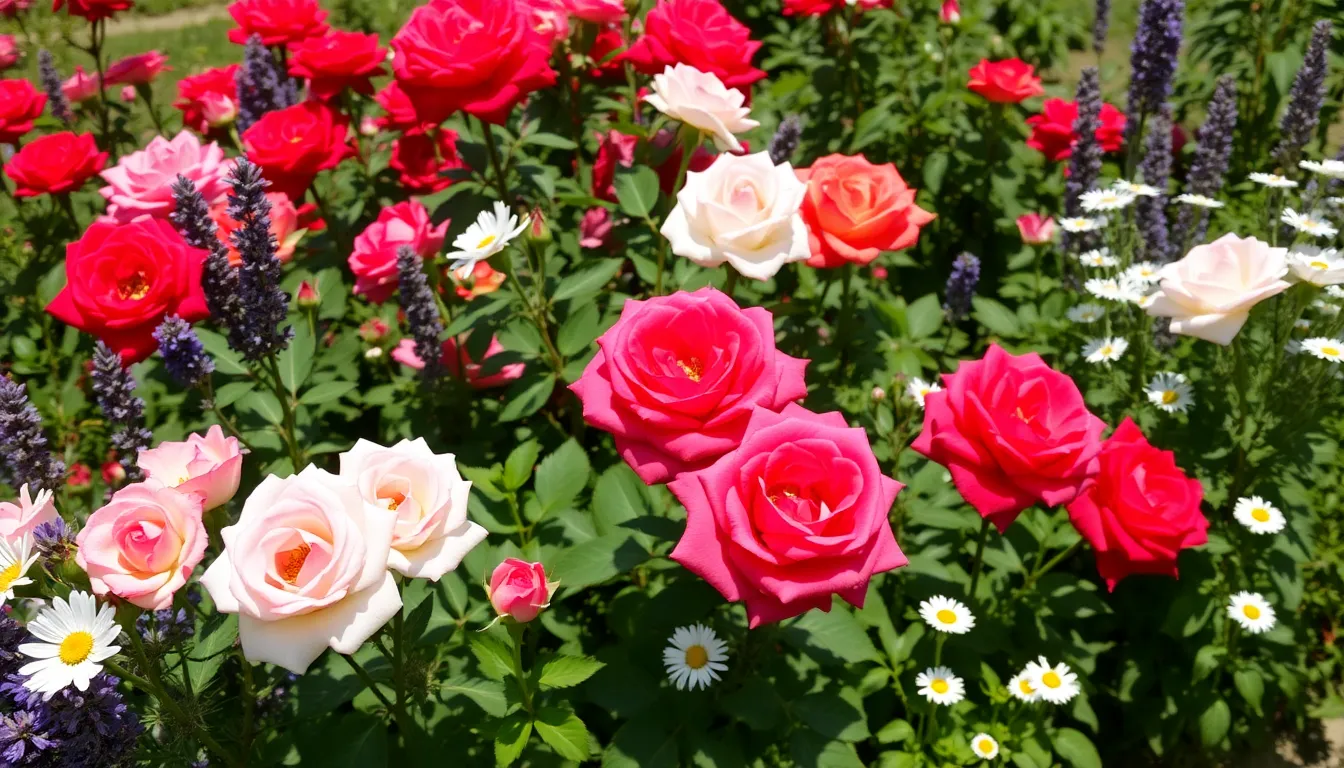
Companion plants enhance the beauty and health of our rose gardens while creating stunning visual displays. Strategic planting selections transform ordinary rose beds into extraordinary landscapes that thrive naturally together.
Choose Plants That Complement Rose Colors
Artemisia and Lamb’s Ear create beautiful backdrops with their soft silvery foliage that makes rose colors pop dramatically. We love how these plants accentuate deep red roses like ‘Mister Lincoln’ and soft pink varieties such as ‘Queen Elizabeth’. English Lavender adds another dimension with its pale green leaves that enhance sumptuous rose blossoms throughout the growing season.
Shasta Daisies provide crisp white blooms that complement any rose color while requiring similar maintenance schedules. Their cheerful faces create perfect contrast against dark foliage roses and burgundy varieties. We recommend planting them in clusters of 5 to 7 plants for maximum visual impact in full sun gardens.
Select Pest-Deterrent Companion Plants
Lavender serves double duty as both a beautiful companion and natural pest repellent for our rose gardens. Its aromatic oils help deter aphids, spider mites, and other common rose pests while attracting beneficial pollinators like bees and butterflies. We suggest planting English Lavender varieties 2 to 3 feet away from rose bushes for optimal spacing.
Catmint (Nepeta) offers feathery purple and blue-gray appearances that create stunning contrasts with rose blooms. This hardy perennial deters ants, mosquitoes, and rodents while requiring minimal water once established. Plant catmint in groups of 3 to 5 for best coverage and pest deterrent effects.
Allium bulbs add architectural interest with their spherical flower heads while their onion-like scent naturally repels aphids and other soft-bodied insects. We recommend varieties like ‘Purple Sensation’ or ‘Globemaster’ for dramatic height differences and long-lasting blooms.
Add Ground Cover and Border Plants
Stonecrop (Sedum) varieties create perfect low-growing carpets at the base of rose bushes while requiring minimal water and maintenance. These succulent plants thrive in the same well-draining conditions that roses prefer. We suggest ‘Dragon’s Blood’ Sedum for its red foliage that complements pink and white roses beautifully.
Russian Sage (Perovskia atriplicifolia) frames rose borders with bright purple blooms and silvery stems that sway gracefully in summer breezes. This drought-tolerant perennial grows 3 to 4 feet tall and creates stunning backdrops for shorter rose varieties. Plant Russian Sage 4 to 5 feet from rose bushes to allow proper air circulation.
Tickseed (Coreopsis) thrives in moist, well-drained soil conditions similar to roses while providing cheerful yellow blooms for cut flower arrangements. These plants bloom continuously from summer through fall with regular deadheading. We recommend varieties like ‘Moonbeam’ for delicate texture or ‘Zagreb’ for compact growth habits.
Catmint, Lavender, and Verbena work together as living mulches that suppress weeds naturally while shading soil around rose roots. This combination creates a tapestry of colors and textures that changes throughout the seasons. Plant these companions in irregular drifts rather than straight lines for the most natural appearance.
Install Proper Support Systems
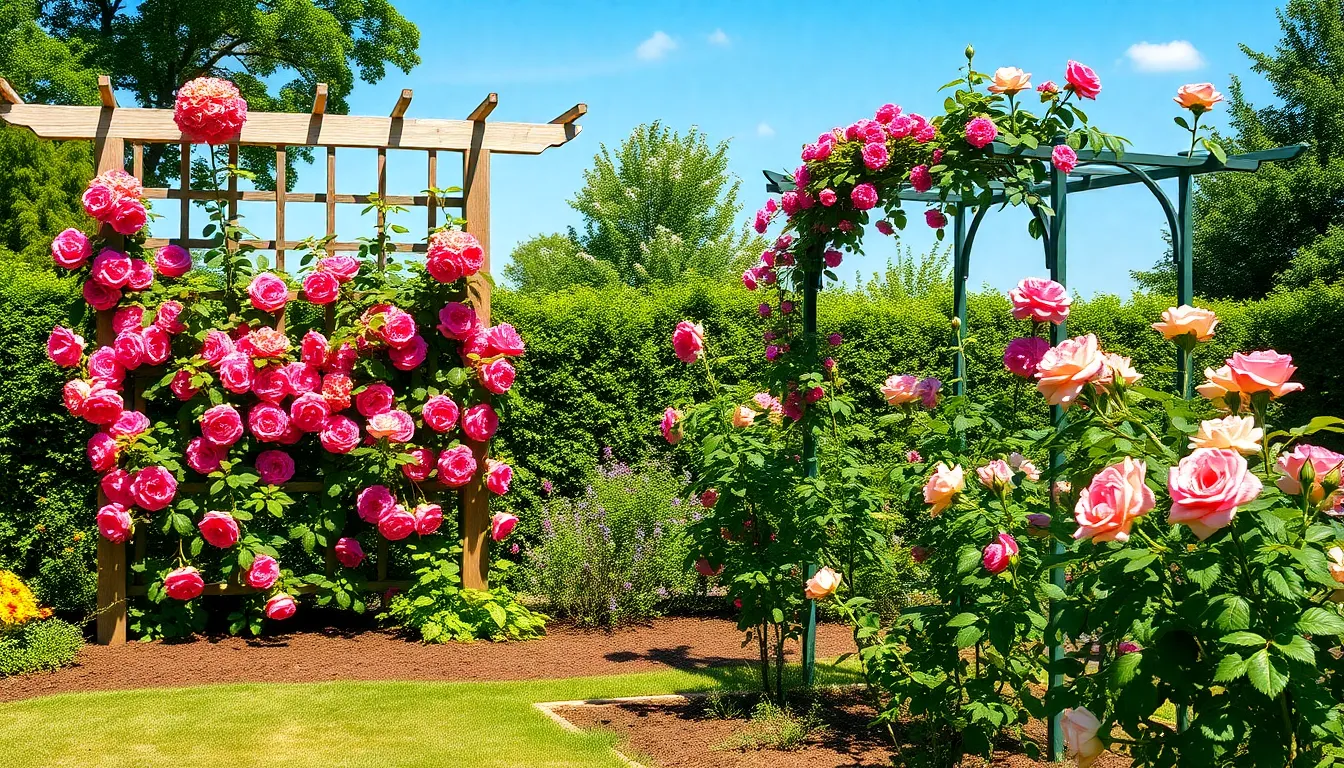
Support systems prevent wind damage and help roses display their blooms at their absolute best. We’ll show you how climbing roses, pillar varieties, and bush roses all need different types of sturdy frameworks to thrive and create stunning vertical displays.
Set Up Trellises for Climbing Varieties
Trellises provide essential vertical growing structures that climbing roses require for proper development. Position these supports in sunny locations with well-drained, fertile soil to maximize rose performance. Plant your climbing roses approximately 10 inches away from the trellis structure to allow adequate space for training and natural growth patterns.
Incorporate generous amounts of organic compost around the base to boost initial growth and establish strong root systems. We recommend choosing decorative trellis designs that enhance your garden’s aesthetic appeal while providing functional support for rose canes. Wire support systems attached to existing fences offer additional tie points for securing climbing rose branches as they mature.
Install Garden Arbors and Pergolas
Arbors and pergolas create elegant frameworks that transform climbing roses into living architectural features. These larger structures add important height and sophisticated style to garden spaces while providing naturally shaded seating areas decorated with fragrant rose blooms. Scale these installations appropriately to complement both your roses and overall garden layout for the most visually striking results.
Design considerations should include the mature size of your chosen rose varieties and their eventual spread patterns. We suggest positioning arbors at garden entrances or along pathways to create dramatic focal points that welcome visitors with cascading rose displays.
Create Sturdy Stakes for Bush Roses
Bush and shrub roses benefit from individual stakes that keep branches upright when heavy blooms weigh down the canes. Green wire fencing rolled into cylindrical shapes provides affordable yet strong support options for multiple rose bushes. Galvanized metal stakes offer long-lasting durability and can withstand harsh weather conditions without deteriorating.
Horizontal support wires can be added between vertical pillars to secure roses in narrow garden spaces or tight planting areas. We recommend installing stakes early in the growing season before roses reach full size to avoid disturbing established root systems. This proactive approach ensures your bush roses maintain their shape and display blooms at eye level throughout the growing season.
Plan Your Rose Garden Maintenance Schedule
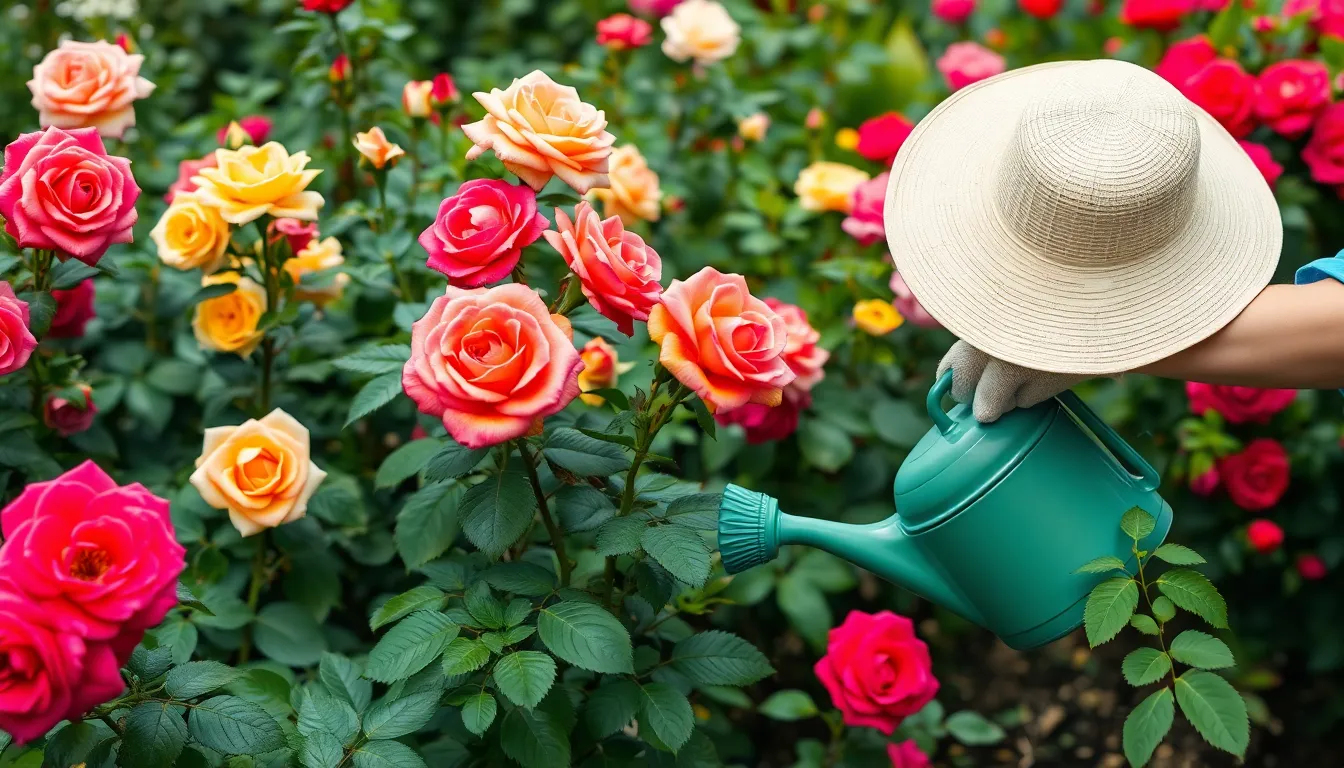
Creating a systematic maintenance schedule ensures our roses receive consistent care throughout the growing season. Following a structured timeline helps maximize bloom production while preventing common problems before they start.
Establish Regular Watering Routines
Consistent moisture levels form the foundation of healthy rose growth, especially during hot weather periods. We recommend watering deeply at the base of plants rather than overhead to prevent leaf diseases and fungal issues.
Morning watering works best because it allows foliage to dry quickly throughout the day. Deep, infrequent watering encourages strong root development compared to frequent shallow watering sessions.
Overwatering poses serious risks including root rot and other moisture related complications. We should check soil moisture by inserting our finger 2-3 inches deep before adding more water.
Mulching around rose plants helps retain consistent soil moisture while reducing watering frequency. Organic mulches like shredded bark or compost also improve soil structure as they decompose.
Schedule Pruning and Deadheading
Late winter or early spring provides the optimal timing for major pruning activities that promote new growth and encourage abundant blooming. January pruning should focus on reducing plant size while applying fresh planting mix around the base.
March brings the perfect opportunity to prune repeat blooming roses and remove any diseased foliage from winter damage. Removing dead, damaged, or crossing branches improves air circulation and prevents disease spread.
Deadheading spent blooms throughout the growing season encourages continuous flower production and maintains an attractive garden appearance. We should cut back to the first five leaflet leaf to promote strong new growth.
August pruning requires cutting roses by half their current height to prepare plants for fall growth and winter dormancy. This timing helps roses develop strong root systems before cold weather arrives.
Sharp, clean pruning tools prevent disease transmission between plants and create clean cuts that heal quickly.
Plan Seasonal Fertilization Programs
Spring fertilization begins after the ground thaws with granular rose fertilizer application to support early season growth. February marks the ideal time to apply rose exact food along with preventive pest control measures.
Summer feeding continues from April through July using balanced fertilizers like 10-10-10 to maintain steady growth and bloom production. Adding Epsom salts during summer months provides extra magnesium that roses need for chlorophyll production.
Fall fertilization supports plant health during cooler months with rose exact formulations that help plants prepare for winter dormancy. This final feeding should occur before the first expected frost date in our area.
Regular fertilization schedules produce more vigorous plants with increased disease resistance and longer bloom periods. We should always follow package directions and avoid over fertilizing, which can promote excessive foliage growth at the expense of flowers.
Add Decorative Elements to Enhance Your Garden

Transform your rose garden into a stunning outdoor sanctuary with carefully chosen decorative elements. These additions create visual interest while providing practical benefits that enhance both beauty and functionality.
Install Garden Benches and Seating Areas
Garden benches serve as perfect resting spots where we can appreciate our roses’ fragrance and beauty up close. Position wooden or wrought iron benches strategically along garden paths to create natural stopping points for visitors. Stone seats work exceptionally well near climbing rose displays, offering comfortable viewing angles of vertical blooms.
Install seating areas in shaded spots beneath rose covered pergolas for comfortable relaxation during warm afternoons. Curved benches around circular rose beds create intimate gathering spaces that encourage conversation. We recommend placing benches 6 to 8 feet away from rose bushes to avoid thorns while maintaining optimal viewing distance.
Consider adding cushions or weather resistant pillows in colors that complement your rose varieties. Built in storage benches provide convenient space for garden tools and supplies while serving dual purposes in smaller gardens.
Incorporate Water Features
Water features bring tranquil sounds and cooling effects that enhance any rose garden atmosphere. Small fountains positioned near entrance roses create welcoming focal points that greet visitors with gentle water sounds. Shallow ponds reflect climbing roses on nearby trellises, doubling their visual impact through natural mirroring.
Install birdbaths among your rose beds to attract beneficial wildlife that helps control garden pests naturally. Solar powered water features eliminate electrical installation costs while providing eco friendly operation throughout the day. Recirculating fountains conserve water while maintaining continuous flow that masks street noise.
Position water elements where morning sunlight can create sparkling effects on moving water surfaces. We suggest placing larger features like ponds at least 10 feet from rose plantings to prevent excessive moisture that could promote fungal diseases.
Add Decorative Mulch and Edging
Decorative mulch transforms ordinary rose beds into polished industry features while providing essential plant benefits. Colored mulches like dark brown or burgundy create striking contrasts against light colored roses such as white or pale pink varieties. Natural options including shredded bark and cocoa hulls complement traditional garden aesthetics.
Apply mulch 2 to 3 inches deep around rose bushes, keeping material several inches away from plant stems to prevent moisture related problems. Decorative stone mulch works well in formal gardens, offering permanent answers that don’t require annual replacement.
Install crisp edging materials to define rose bed boundaries and prevent grass encroachment. Steel or aluminum edging provides clean lines that separate lawn areas from planted spaces effectively. Natural stone borders create rustic charm while brick edging adds classic elegance to cottage style gardens.
We recommend combining different edging heights to create visual layers, using taller borders around specimen roses and shorter versions for groundcover varieties.
Create Seasonal Interest Beyond Rose Blooms
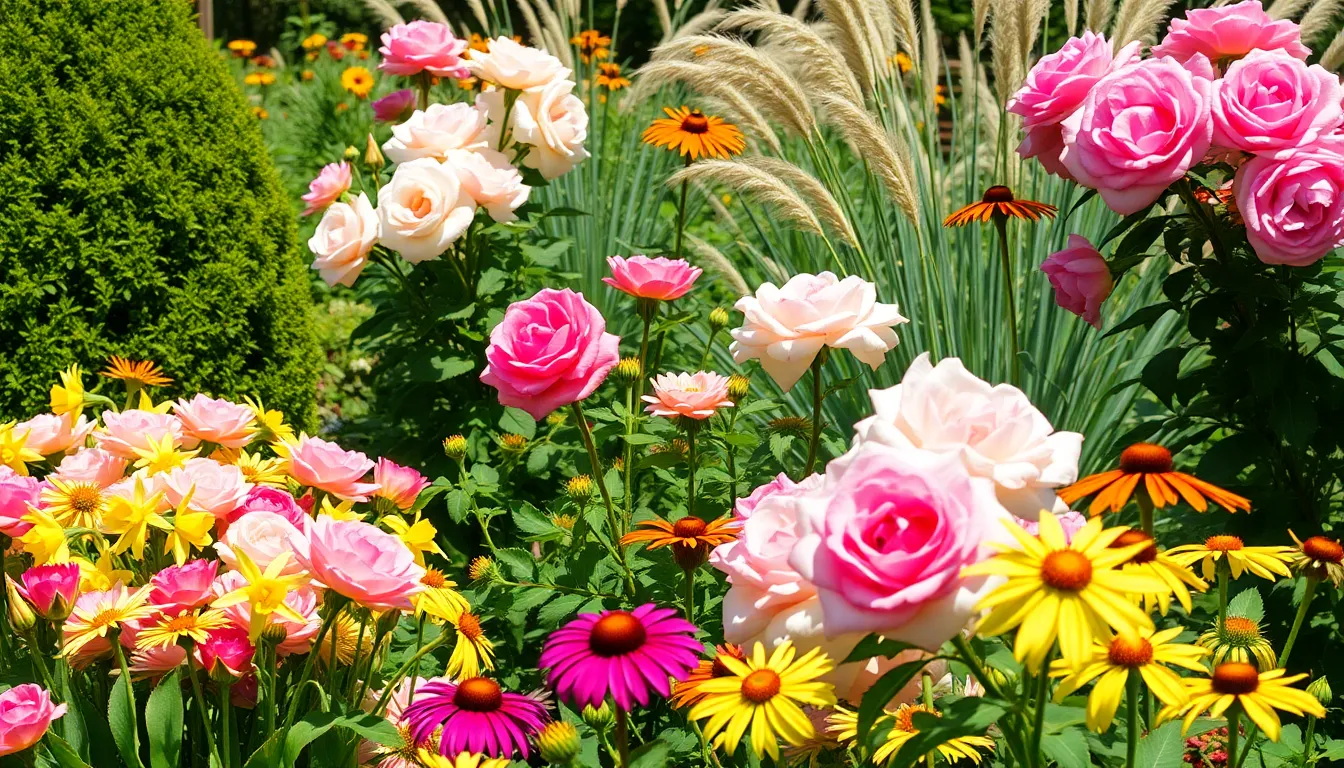
Extending your rose garden’s visual appeal throughout the year requires strategic planning beyond the blooming season. We’ll explore three essential approaches to maintain garden beauty from spring through winter.
Plant Spring Bulbs for Early Color
Tulips create vibrant displays before your roses begin their growing season, offering colors that complement upcoming rose blooms. We recommend planting these spring bulbs in clusters around rose bases to maximize visual impact. Daffodils provide reliable early color year after year with minimal maintenance requirements, making them ideal companion plants for busy gardeners.
Crocuses emerge as some of the first flowers each spring, creating cheerful carpets of purple, white, and yellow throughout your rose beds. These hardy bulbs naturalize easily and multiply over time, expanding your spring display without additional effort. We’ve found that combining different bulb varieties creates layered blooming periods that bridge the gap between winter dormancy and rose season.
Add Evergreen Structure Plants
Boxwood establishes year round structure that frames your roses beautifully during both blooming and dormant periods. These versatile evergreens can be shaped into formal hedges or left natural for a more relaxed garden appearance. We often use boxwood to create defined borders that highlight rose plantings while providing winter interest.
Holly brings both structural presence and seasonal berries that add winter color when roses are dormant. Different holly varieties offer various leaf textures and berry colors, allowing you to customize your garden’s winter appearance. We recommend selecting holly cultivars that complement your rose color scheme and provide the desired height for your garden design.
These evergreen plants can be shaped into topiaries or maintained as natural shrubs, adding texture and visual weight to your industry composition. Their consistent green presence creates a stable backdrop that enhances rose blooms during peak season while maintaining garden structure year round.
Include Late-Season Flowering Perennials
Coneflowers extend your garden’s blooming period well into fall, providing purple, pink, and white flowers that complement autumn rose displays. These drought tolerant perennials require minimal care once established and attract beneficial pollinators to your garden. We particularly appreciate how coneflowers’ seed heads add winter interest when left standing through the cold months.
Black eyed Susans offer bright yellow blooms that create stunning contrasts with late season rose colors, maintaining visual appeal through September and October. Their cheerful flowers bridge the transition from summer rose displays to autumn garden interest. Daylilies provide reliable blooms in various colors and heights, creating layered displays that extend the flowering season.
Ornamental grasses like sedges maintain structural interest through different seasons, offering texture and movement that complements both rose blooms and winter garden scenes. These low maintenance perennials add natural grace to formal rose plantings while providing habitat for beneficial insects and birds throughout the year.
Design Theme-Based Rose Garden Ideas
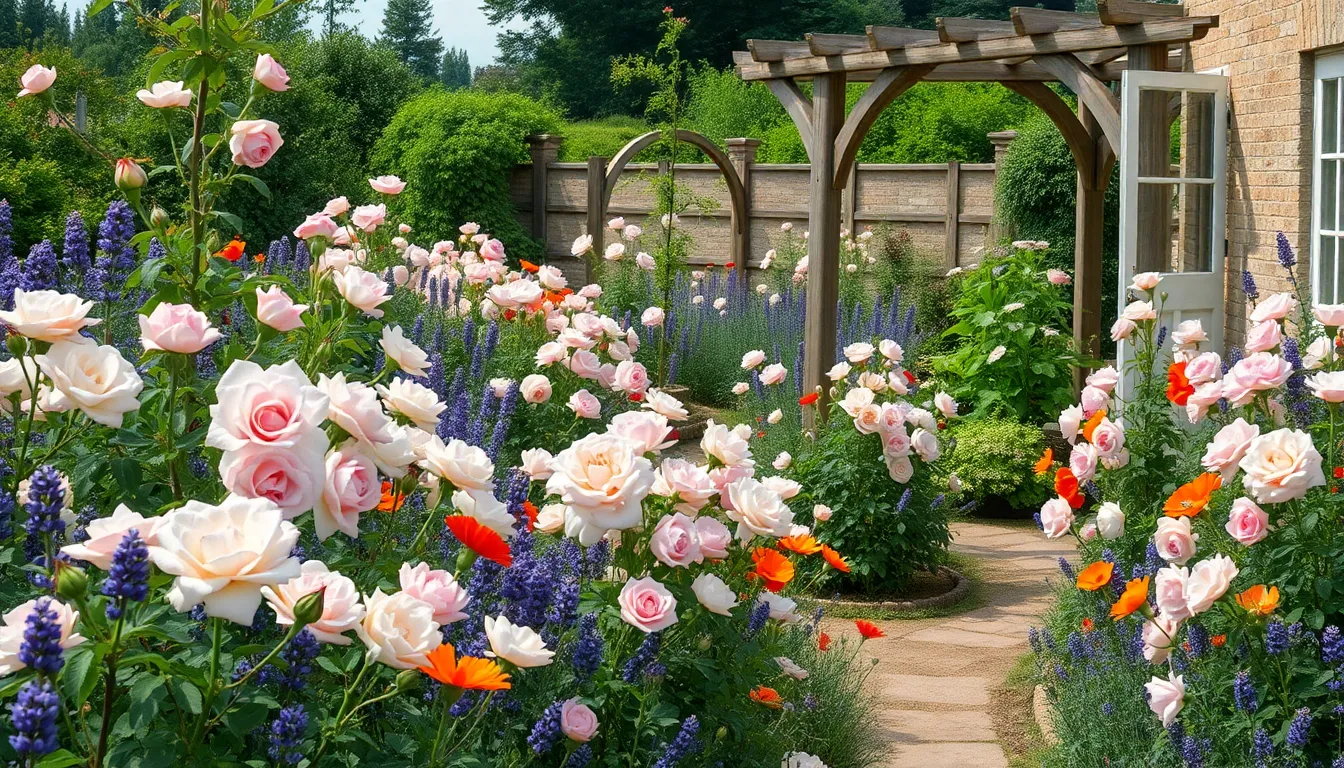
Creating a cohesive theme transforms your rose garden from a simple collection of plants into a stunning industry feature that reflects your personal style.
Create a Cottage Garden Style
Cottage garden style roses blend beautifully with diverse flowering perennials to create an informal, lush sanctuary in your outdoor space. We recommend combining roses with lavender, catmint, delphiniums, and poppies for that authentic cottage charm that feels naturally abundant.
Curved pathways and irregular borders define this relaxed approach to rose gardening. Allow plants to spill gracefully over edges rather than maintaining strict boundaries, creating that wonderfully unkempt charm that cottage gardens are famous for.
Color combinations work best when you mix pastel roses with bold flowering companions for visual contrast. Incorporate plants with varying heights and diverse leaf textures to add layers of visual interest throughout your garden space.
Rustic structures like wooden trellises, weathered gates, or simple garden benches enhance the cottage ambiance perfectly. These elements provide both functional support for climbing roses and authentic decorative touches that complete the informal aesthetic.
Design a Formal Rose Parterre
Symmetrical designs using geometric patterns and repeating shapes create the structured elegance that formal parterres demand. We suggest using low boxwood hedges to edge your rose beds, providing clean lines that emphasize the mathematical precision of this classic style.
Uniform rose varieties like hybrid teas or floribundas planted in neat rows or blocks deliver the groomed appearance essential to formal gardens. Choose varieties that bloom consistently and maintain similar heights for the most polished visual impact.
Hardscaping materials such as gravel, brick, or stone pathways provide the permanent structure that formal gardens require. Consider adding central features like fountains or classical statues to create elegant focal points that draw the eye through your design.
Evergreen shrubs maintain your garden’s formality throughout the off season when roses are dormant. These structural plants ensure your parterre retains its sophisticated appearance year round, providing the backbone that supports seasonal rose displays.
Build a Romantic Moon Garden
White and pale pink roses paired with silver gray companion plants create the serene, glowing effect that makes moon gardens so enchanting at night. We focus on this restrained color palette to maximize the luminous quality that moonlight brings to light colored blooms.
Highly fragrant varieties like ‘Gertrude Jekyll’ or ‘Iceberg’ enhance the sensory experience that romantic moon gardens provide. These roses release their perfume more intensely in the cool evening air, creating an intoxicating atmosphere for nighttime garden visits.
Subtle garden lighting or reflective surfaces amplify the moonlight’s natural illumination throughout your space. Water features and silver foliaged plants act as natural light enhancers, creating a magical ambiance that transforms your garden after dark.
Night blooming plants such as moonflowers complement your roses while silver leafed plants like lamb’s ear and hostas add textural interest. These carefully chosen accent plants ensure your moon garden offers visual appeal even when roses aren’t the primary focus.
Conclusion
We’ve covered everything you need to transform your outdoor space into a stunning rose garden that’ll thrive for years to come. From selecting the perfect location and preparing nutrient-rich soil to choosing complementary plants and installing proper support systems we’ve provided you with a complete roadmap for success.
Remember that creating your dream rose garden doesn’t happen overnight. With consistent care seasonal maintenance and thoughtful design choices you’ll develop a garden that becomes more beautiful with each passing year. Whether you’re drawn to cottage garden charm formal elegance or romantic moonlit themes the possibilities are endless.
Your rose garden journey starts with that first planted rose. Trust the process embrace the learning experience and soon you’ll have a fragrant colorful sanctuary that brings joy to both you and your visitors throughout every growing season.
Frequently Asked Questions
How much sunlight do roses need to grow properly?
Roses require 6 to 8 hours of morning sunlight daily for optimal growth and disease resistance. Morning sun is particularly important as it helps dry dew from leaves, reducing fungal diseases. Choose locations that receive consistent sunlight throughout the day, avoiding areas with heavy shade from trees or buildings.
What type of soil is best for growing roses?
Roses thrive in well-draining, slightly acidic to neutral soil with a pH between 6.0 and 7.0. Sandy loam soil is ideal, but you can improve heavy clay or sandy soil by adding organic matter and compost. Proper drainage is crucial to prevent root rot and promote healthy root development.
Which rose varieties are most disease-resistant?
Oso Easy Roses are highly recommended for their vigor, disease resistance, and extended bloom periods. Other disease-resistant options include newer cultivars that offer improved hardiness over traditional hybrid teas. Choose varieties specifically bred for your climate zone to ensure minimal maintenance and maximum beauty.
How should I space roses in my garden?
Proper spacing between rose plants is essential for good air circulation, which reduces disease pressure. Most bush roses should be planted 3-4 feet apart, while climbing roses need 6-8 feet between plants. Adequate spacing also allows each plant to receive sufficient sunlight and nutrients.
What are the best companion plants for roses?
Excellent companion plants include Artemisia, Lamb’s Ear, and English Lavender, which complement rose colors and deter pests. Shasta Daisies, Catmint, and Allium bulbs provide visual interest and natural pest control. Ground covers like Stonecrop and Russian Sage create a cohesive landscape design.
When and how should I prune my roses?
Prune roses in late winter or early spring before new growth begins. Remove dead, diseased, or crossing branches, and cut back healthy canes by one-third to one-half. Regular deadheading throughout the growing season promotes continuous blooming and maintains an attractive garden appearance.
How often should I water my rose garden?
Water roses deeply but less frequently, focusing on the base of plants to prevent leaf diseases. Most roses need about 1-2 inches of water per week, including rainfall. Mulching around plants helps retain soil moisture and reduces watering frequency while suppressing weeds.
What support systems do climbing roses need?
Climbing roses require sturdy frameworks such as trellises, arbors, or pergolas positioned in sunny locations with well-drained soil. Install supports before planting to avoid disturbing roots later. Tie canes loosely to allow for growth and prevent damage from wind or heavy blooms.

